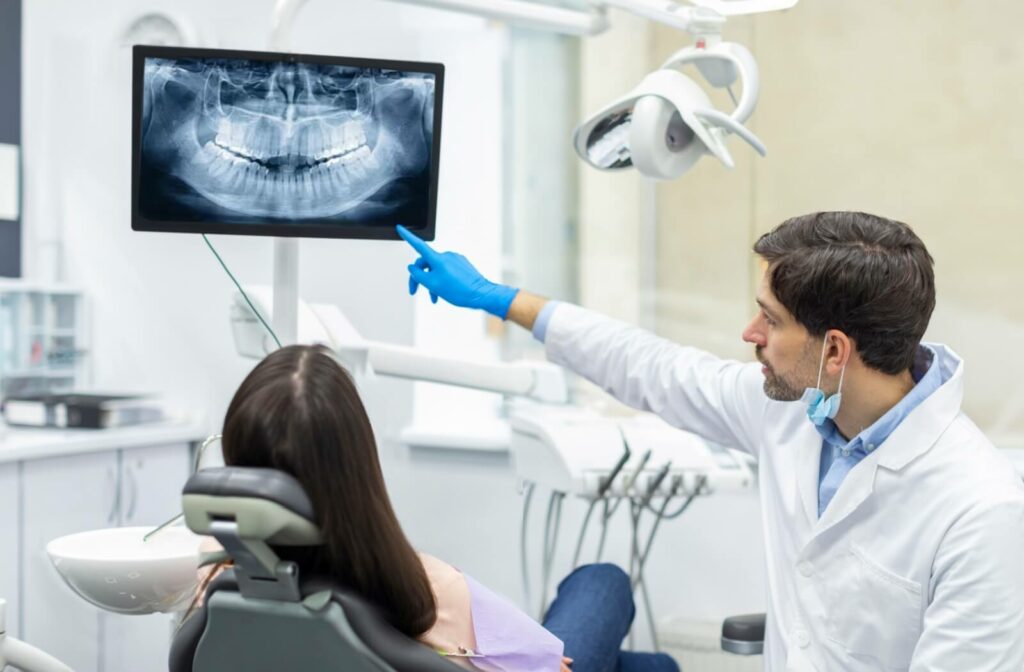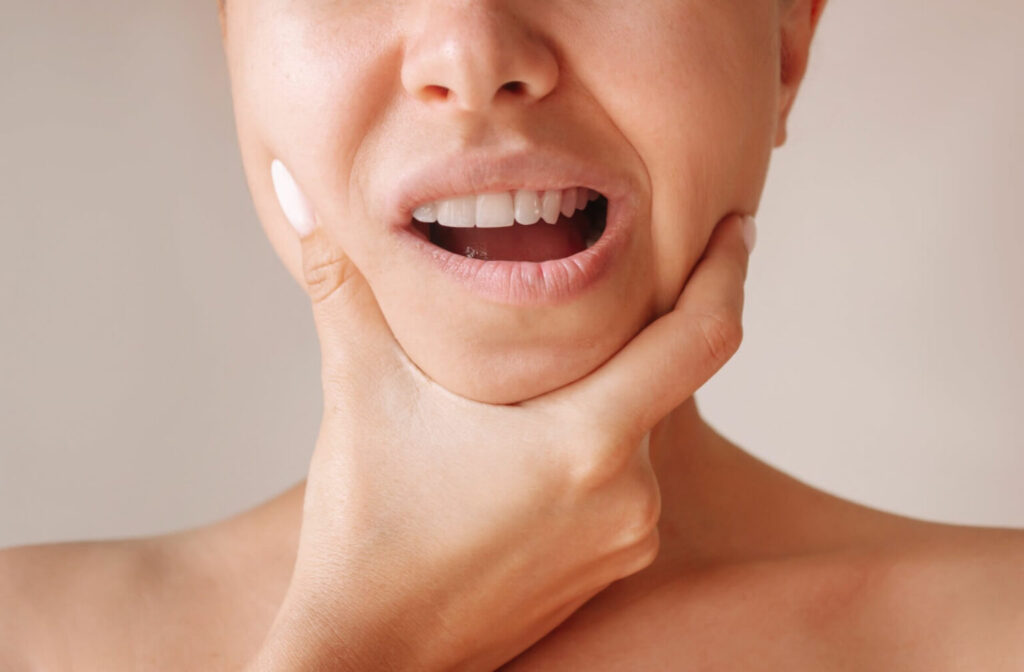If you’ve been dealing with persistent or severe jaw discomfort, clicking sounds when you chew, or stiffness that makes even yawning a chore, you’re not alone. Millions of people experience TMJ disorders, but the good news is that relief is within reach.
Although a permanent cure depends on the underlying cause of your TMJ, there are effective treatment options that can offer effective and long-lasting relief:
- Oral interventions (i.e. nightguards, dental splints, injections, orthodontics)
- Nonsurgical options (i.e. ultrasound therapy, lifestyle changes)
- Physical therapy (exercises, manual therapy, joint mobilization)
- Surgical treatments (arthroscopy, open-joint surgery)
One thing’s for certain: the road to recovery starts with visiting your dentist. An oral exam allows your dentist to evaluate the severity of your condition and recommend solutions tailored to your unique case.
Cracking the Code on TMJ
The temporomandibular joints (TMJ) connect the jawbone to the skull. A TMJ disorder (TMD) occurs when the joint or surrounding muscles become inflamed or dysfunctional.
While it might sound like a jaw-only issue, the effects of a TMJ disorder can extend to other areas, including your ears, head, teeth, face, and neck.
TMJ isn’t typically life-threatening, but persistent jaw discomfort, difficulty eating, or recurring migraines can significantly impair your quality of life.
Many people find that early and effective treatment can completely relieve TMD symptoms. However, achieving a “permanent cure” can differ from person to person and depends on the underlying cause and severity:
Common factors include:
- Bruxism (grinding or clenching your teeth)
- Jaw injuries or trauma
- Arthritis in the jaw joint
- Stress, which can lead to muscle tension in the jaw
- Misaligned teeth or bite problems
- Habitual chewing of gum or nail-biting
Stress and muscle tension are examples of treatable causes of TMJ. Your healthcare team can help resolve these factors with the right interventions. Meanwhile, structural or severe arthritis may require ongoing management rather than a one-time fix.
Your Options for Treating TMJ Discomfort
Treating TMJ focuses on relieving severe discomfort, reducing inflammation, and restoring proper function.
Although no one method can permanently cure TMJ, we can manage and improve most cases using a combination of treatments and lifestyle changes.
Below, we’ll explore some treatment options that can provide lasting relief.
Oral Interventions
Your dentist will assess your symptoms, jaw alignment, and bite to determine a personalized approach. They may also take X-rays when necessary to pinpoint the cause of your TMJ issues.
Your dentist may suggest oral interventions to target and improve TMJ based on this evaluation.
Nightguards or Dental Splints
Wearing a nightguard or dental splint can help prevent teeth grinding and jaw clenching while you sleep. It’s a custom-fitted mouthguard that can help alleviate joint pressure and protect your teeth from damage.
Injections
Botox injections can relax overactive jaw muscles. It’s a nonsurgical treatment that can significantly reduce discomfort, alleviate muscle tension, and improve mobility.
Orthodontics
Treatments like braces or Invisalign can correct tooth misalignment and bite issues. A straighter, properly aligned bite can reduce strain on the jaw joint.

Nonsurgical Options
An advantage of nonsurgical (and oral) treatments is that many pair well with other approaches. The flexibility allows your dentist to create a customized treatment approach to help bring you the meaningful relief you’re looking for.
Nonsurgical options include:
- Trigger point therapy is a hands-on therapy that helps release tight muscle knots in the jaw, allowing surrounding muscles to relax & reduce tension
- Ultrasound therapy helps gently warm the muscles & joints using sound waves to improve circulation & ease stiffness or discomfort
- Lifestyle changes can include avoiding hard or chewy foods, practicing stress management, & focusing on good posture to significantly reduce strain on your jaw
Physical Therapy
Physical therapy for TMJ often focuses on gentle jaw stretches, resistance exercises, and precise, controlled movements to help realign and stabilize the joint.
A licensed physical therapist can guide you through stretches and strengthening exercises to improve jaw mobility, ease discomfort, and even address tension in your neck and shoulders.
Surgical Treatments
There are several surgical options for treating TMJ, but 2 common methods include:
- Arthroscopy is a minimally invasive procedure that involves inserting a small camera & specialized tools through a tiny incision so your surgeon can directly assess & treat the joint by removing scar tissue, smoothing joint surfaces, or addressing inflammation
- Open-joint surgery (arthrotomy) is a more advanced option that uses a larger incision to fully access the joint to remove & replace tissue, remove bone spurs, or resolve major structural problems
At Shin Dentistry, we prioritize your comfort and care by first exploring nonsurgical options and only recommending surgery when necessary.
Adopting Lifelong Habits: Preventing TMJ
Not all cases of TMJ are preventable, such as jaw injuries or genetic factors. However, there are proactive steps you can take to reduce your risk of developing this condition.
Adopting these habits can also complement other treatment measures, like injections or physical therapy:
- Practice good posture, as poor posture can strain your jaw & neck
- Avoid slouching & align your head with your spine when sitting or standing
- Avoid teeth grinding, including while you sleep
- Bruxism and night grinding can be treated; talk to your dentist about a custom nightguard to protect your jaw & teeth
- Limit jaw strain by reducing habits that stress your jaw, such as chewing gum or biting your nails
- Stick to softer foods if your jaw feels overworked & discourage prolonged thumb-sucking in children
- Stress management can help reduce habits that add to jaw tension or teeth-grinding
- Incorporate stress-relief techniques into your daily life, such as deep breathing, meditation, or exercise
- Address orthodontic concerns early, such as misaligned bites, that can strain the jaw joint
- Early orthodontic treatment can correct dental alignment & lower the risk of TMJ
- Schedule regular dental visits to help monitor your teeth & your oral health
- At routine dental checkups, your dentist can evaluate your jaw health, spot early signs of TMJ issues, & recommend preventative solutions
Take the First Step Toward TMJ Relief
Living with TMJ disorder can be daunting, but it doesn’t have to be an everyday reality. The first step on the road to long-term relief is visiting your dentist.
Whether your jaw discomfort needs dental interventions or gentler, nonsurgical therapies, at Shin Dentistry, we’re here to guide you toward long-term solutions tailored to your needs. Schedule an appointment today and leave TMJ’s discomfort behind.



